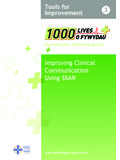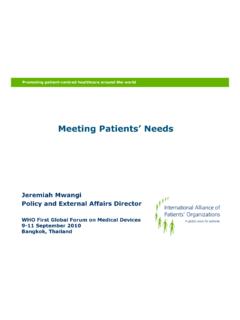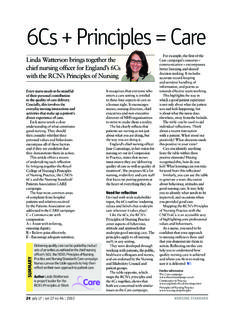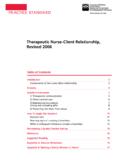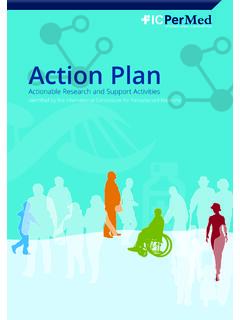Transcription of Co-producing services - Co-creating health
1 Co-producing services - Co-creating health8Co-producing services Co-creating healthAcknowledgementsThis Tools for Improvement guide has been written by Mike Spencer, Ruth Dineen, and Andrew authors would particularly like to thank the following people for their contribution to this guide: Constance Adams, Leslie Rudd, Margaret Rennocks, Helen Sullivan, Mark Taubert, Michelle Copeman, Michelle Graham, Natalie Savery, Peter Llewellyn, Simone Joslyn, Sarah Puntoni, Jon Matthias, Emma Falkner, Maria Gallagher, Helen Howson, Wayne Jepson, Simon Pickthall, Roger Rowett, Paul Swann, Chris Vanstone and Paula Walters. The guide has been published by the 1000 Lives Improvement service, based in Public health Wales, which supports organisations and individuals to deliver the highest quality and safest healthcare for the people of Wales.
2 Date of publicationThis guide was first published in 2013. The latest version will be available on the 1000 Lives Improvement website, purpose of this guideThis guide has been produced to enable healthcare organisations and their teams to successfully implement a series of interventions to improve the safety and quality of care that their patients receive. It is recommended this guide is read in conjunction with the following: How to Improve - The guide for reliable and sustained improvement The 1000 Lives Improvement Service Quality Improvement Guide Learning to use Patient Stories for ImprovementThese are available from 1000 Lives services Co-creating healthContents51. Preface 2. Defining Co- production Context What is co- production ?
3 What is impact of co- production ? Co- production in health and Social Care Co- production and improving Quality Together3. Co-producing services Introduction Step 1: Identify and build your initial team Step 2: Define and share assets - what can be built on Step 3: Co-create the vision - develop will Step 4: Co-designing the solution - build ideas Step 5: Co-delivery building execution Step 6: Co-evaluation measure the impact of change Step 7: Share the evidence and celebrate success4. Co-creating health Introduction Step 1: Share knowledge evaluate known information Step 2: Have conversations, build partnerships health interactions Step 3: Additional Information Step 4: Shared Understanding of options Step 5: Agreement of way forward Step 6: Facilitation of agreed action(s) and choice(s) Step 7: Evaluation of outcomes Step 8: Clinical Audit Step 9: Continuous Improvement5.
4 Getting Started Introduction Training and support A selection of organisations using co-design in health and social care Reading list46122738Co-producing services Co-creating PrefaceThere is much discussion about the role of co- production as part of the response to the current challenges to the delivery of public services . There are many articles and documents describing co- production and many aspects to what it encompasses and how it is guide serves as an introduction to some of the thinking behind the interest in co- production , how it fits with current NHS thinking in Wales and introduces some of the techniques and processes that are used. It aims to stimulate interest and ideas about how and where co- production can support services design, delivery and evaluation and how the principles can be applied at an individual patient level to support management of long term also shows how co- production can support the delivery of person-centred care, which prioritises putting patients, their families and carers at the heart of all decisions and plans about health care.
5 It sees patients as equal partners in planning, developing and assessing care to make sure it is most appropriate for their care aims to be patient focused, to promote independence and autonomy, provide choice and control and be based on a collaborative team philosophy. It takes into account service users needs and views and builds relationships with family It requires both safe and effective care and an expectation of a good experience .The delivery of person centered care should result in a good experience for the patient. NHS Wales identified the need to be able to describe the key determinants of a good experience as a guide to assessing how patients feel when they receive care and key lesson from the public inquiry into the Mid Staffordshire NHS Foundation Trust, chaired by Robert Francis QC (the Francis Report)
6 2, the Department of health review and response to Winterbourne View Hospital3, and the review into the quality of care and treatment provided by 14 hospital trusts in England led by Professor Sir Bruce Keogh4 is that service providers need to develop more equal partnerships with people who use services , together with their families and support a focus on improving patient experience, a National Service User Experience Framework5 for NHS Wales was launched in 2013, based on national and local published evidence. It includes the following three domains which describe the key determinants of a good patient services Co-creating healthFirst and Lasting Impressions which includes: Being welcomed in an appropriate manner.
7 Being able to access services in a timely way. Being treated with dignity and care in a Safe, Supportive, Healing Environment which includes: Receiving care in a clean, clutter free environment. Receiving good, nutritious, appropriate food. Having access to drinks. Having rigorous infection control practices in and Involvement in Care which includes: Receiving appropriate, timely, accessible information. Being communicated with in an appropriate, timely manner. Being involved in decisions about choice of treatment options and care plans, including discharge. Involvement of carers and families in decisions, especially about range of methods are available to gain user feedback, including surveys and patient stories.
8 Information gained from patient feedback is helpful in shaping priority areas for improvement and to be successful, an approach based on the principles of co- production will ensure full patient and public involvement in improvement activities and in tracking the impact they have on the patient experienceCo-producing services Co-creating Defining Co-productionNHS Wales, like all public services , faces severe challenges including increasing demand, changing expectations, increasing burden of chronic disease and the health needs related to an increase of very elderly people in the population. These challenges are made more urgent by the impact of the current economic situation. Although the NHS in Wales with its structure of integrated health Boards and responsibility for public health is well placed to meet the increasing challenges it seems unlikely that sustainable improvements in services and health and well being will be delivered simply through restructuring services or efficiency drives.
9 A new way of working is needed with NHS staff, patients and the community seeing their roles differently and behaving in a different is a growing consensus that co- production is such a way forward, a view supported by the health Minister, Deputy health Minister and Chief Medical Officer6. In response to an open letter from Co- production Wales (All in This Together)7 in May 2013, advocating the widespread adoption of co- production principles at the heart of public services in Wales, the First Minister replied that he and Ministerial colleagues see increased co- production in the design and delivery of public services as an imperative8. The First Minister also confirmed that co- production will be central to the forthcoming Social services and Well-being (Wales) Bill.
10 The Bill aims to promote the empowerment of service users by giving them a stronger voice and greater control over services and will, when introduced, transform the way in which many public services in Wales are delivered and experienced. The Welsh Government Quality Delivery Plan9 for the NHS in Wales sets out the clear vision for a quality-driven NHS Wales. This is to achieve the triple aim of: Providing the highest possible quality and excellent experience. Improving health outcomes and helping reduce inequalities. Getting high value from all our services . This means providing services that are safe, effective, accessible, affordable and sustainable - reducing harm, variation and waste. It means delivering person-centred care to all our patients and re-designing and delivering services to achieve this aim.





